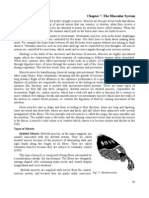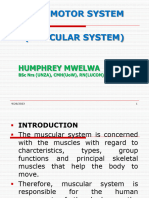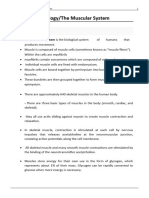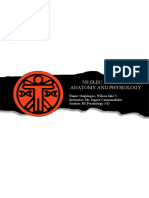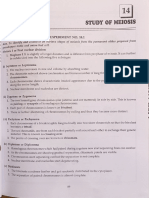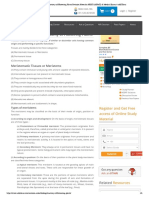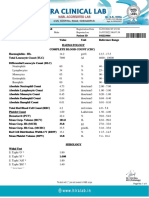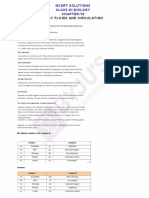0 ratings0% found this document useful (0 votes)
2 viewsAnatomy Part 7a
Anatomy Part 7a
Uploaded by
samkelisiwesigwazaCopyright:
© All Rights Reserved
Available Formats
Download as PPTX, PDF, TXT or read online from Scribd
Anatomy Part 7a
Anatomy Part 7a
Uploaded by
samkelisiwesigwaza0 ratings0% found this document useful (0 votes)
2 views13 pagesOriginal Title
Anatomy Part 7a (1)
Copyright
© © All Rights Reserved
Available Formats
PPTX, PDF, TXT or read online from Scribd
Share this document
Did you find this document useful?
Is this content inappropriate?
Copyright:
© All Rights Reserved
Available Formats
Download as PPTX, PDF, TXT or read online from Scribd
Download as pptx, pdf, or txt
0 ratings0% found this document useful (0 votes)
2 views13 pagesAnatomy Part 7a
Anatomy Part 7a
Uploaded by
samkelisiwesigwazaCopyright:
© All Rights Reserved
Available Formats
Download as PPTX, PDF, TXT or read online from Scribd
Download as pptx, pdf, or txt
You are on page 1of 13
Muscle Tissue
Although bones provide leverage and form the framework of the body,
they cannot move the body on their own. Motion results from the
alternating contraction (shortening) and relaxation of muscle tissue,
which constitutes 40-50% of total body weight
Types of Muscle Tissue:
The three kinds of muscle tissue
– skeletal, cardiac and
smooth –
differ from
one another in their microscopic
anatomy, location and control
by the nervous and endocrine
Skeletal muscle tissue - Attached primarily to bones, and moves
parts of the skeleton. Described as striated because alternating
light and dark bands are visible when examined under a
microscope. It is a voluntary muscle tissue, as it can be made to
contract and relax by conscious control.
Cardiac muscle tissue - Forms most of the heart. Also striated,
but is involuntary; its contraction is usually not under conscious
control.
Smooth muscle tissue – Located in the walls of hollow internal
structures, such as blood vessels, stomach, intestines. Also found
in the skin attached to hair follicles. Under microscopic view,
appears nonstriated / smooth, and usually is involuntary muscle
tissue.
Functions of Muscle Tissue:
Muscles have four key functions: producing motion,
providing stabilization, moving substances, and generating
heat.
1. Motion – Seen in movements such as lifting limbs and
walking, and in localised and highly co-ordinated movement
patterns like grasping a pen. Movement relies on integrated
functioning of bones, muscles and joints.
2. Stabilization – Besides from movement, muscle tissue
contractions also maintain stable body positions
3. Movement of substances – Cardiac muscle contractions
pump blood to all body areas and help maintain blood
pressure. Smooth muscle contractions aid in movement of
substances through the digestive, reproductive and urinary
systems
4. Thermogenesis – As skeletal muscle contracts to perform
work, a by-product is heat. Muscle is metabolically active
tissue and is therefore involved in maintaining body
temperature (muscle tissue can generate up to 85% of body
heat)
Characteristics of Muscle Tissue:
Five characteristics of this tissue type allow it
to carry out its functions
Excitability: a property of both muscle cells
and nerve cells; it is the ability to respond to
certain stimuli by producing electrical signals
called action potentials (impulses)
Conductivity: is the ability of a cell, especially
a muscle or nerve cell, to conduct action
potentials along the cell/plasma membrane
Contractility: is the ability of muscle tissue to shorten and
thicken (contract), thus generating force, to do work
Extensibility: describes that muscles can be extended
(stretched) without damaging the tissue. Most skeletal muscles
are arranged in opposing pairs; while one is contracting, the
other not only is relaxed but also is often being stretched.
Elasticity: relates to muscle tissue tending to return to its
original shape after contraction or extension
Skeletal Muscle Structure:
Three layers of dense, irregular connective tissue protect
and strengthen skeletal muscle. The outermost layer,
encircling the whole muscle is the epimysium. The
perimysium surrounds bundles of 10-100 or more individual
muscle fibres; which are called fascicles. Penetrating into the
interior of each fascicle and separating individual muscle
fibres from one another is endomysium.
All three of the above are all continuous with the connective tissue that
attaches the muscle to other structures, such as bone or other muscles.
All three connective tissue
layers may extend beyond
the muscle fibres to form a
tendon, which attaches a
muscle to the periosteum
on a bone.
Some tendons are
enclosed in their own layer
of connective tissue,
called tendon sheaths.
Similar to bursae, they
reduce friction as tendons
contract.
Microscopic Structure of Skeletal Muscles
Hundreds or thousands of very long, cylindrical cells
called muscle fibres or muscle cells can be seen under
microscopic view. These run parallel to one another.
The plasma membrane of a muscle cell is called a
sarcolemma, which surrounds the fibre cytoplasm, the
sarcoplasm.
At high magnification the sarcoplasm appears filled with
little threads, which are called myofibrils.
Myofibrils are the contractile elements of skeletal
muscle. They contain three types of even smaller
structures called filaments (myofilaments).
Thick filaments are formed by the contractile protein
myosin
Thin filaments are formed by the contractile protein actin
The protein titin makes up the elastic filaments
Muscle Fibre Types:
Skeletal muscle fibres are not all identical in structure and
function. For example, they vary in colour depending on
amount of myoglobin, a red coloured protein.
Skeletal muscle fibres that have a high myoglobin content are
termed red muscle fibres; while those with low myoglobin
content are termed white muscle fibres.
Red fibres also have more mitochondria and blood capillaries.
Slow Oxidative / Type I fibres : Smallest in diameter, also
called slow-twitch or fatigue resistant fibres. They contain
large amounts of myoglobin, many mitochondria and blood
capillaries; thus look red. High capacity to generate ATP via
the aerobic system, ie. oxidative
Fast Oxidative / Type II a fibres : Intermediate in
diameter, also called fast-twitch or fatigue-resistant fibres.
They also have large amounts of myoglobin, mitochondria
and capillaries. Therefore red in colour, and high oxidative
capacity. Most athletes tend to have a high
number of these fibres.
Fast Glycolytic / Type II b / II x : Largest in diameter, also
called fast-twitch or fast-fatiguing fibres. They have low
myoglobin content, few mitochondria and relatively few blood
capillaries; appear white/light in colour. They are poor at
regenerating ATP oxidatively, but use stored carbohydrates in
the form of glycogen to re-form ATP; ie. glycolytic
Most skeletal muscles are
a mixture of all three
types, but their proportion
varies depending on
genetics, the usual
muscle action of the
muscle, and exercise
You might also like
- Bio411 Lab Report 2Document25 pagesBio411 Lab Report 2Nur Aqillah100% (1)
- Skeletal MuscleDocument32 pagesSkeletal MuscleArfiNo ratings yet
- Muscular System PptDocument13 pagesMuscular System PptMardiyya ZubaerNo ratings yet
- Muscle and Connective TissueDocument8 pagesMuscle and Connective Tissuedavoujohn0No ratings yet
- THE MUSCULAR SYSTEM by Mr. Olayi-1Document8 pagesTHE MUSCULAR SYSTEM by Mr. Olayi-1Dominic OlayiNo ratings yet
- Skeletal Muscle NotesDocument15 pagesSkeletal Muscle Notessf3841043No ratings yet
- Structure of the Muscle (1)Document6 pagesStructure of the Muscle (1)victoriamusyoka66No ratings yet
- Human Anatomy and Physiology W3 - EmmanuelaDocument5 pagesHuman Anatomy and Physiology W3 - EmmanuelaRamizNo ratings yet
- Module 5 MUSCULAR SYSTEMDocument20 pagesModule 5 MUSCULAR SYSTEMMisha WilliamsNo ratings yet
- Zoology Notes: 011 Chapter 7Document4 pagesZoology Notes: 011 Chapter 7humanupgradeNo ratings yet
- Muscle PhysiologyDocument7 pagesMuscle Physiologymichealadegoke154No ratings yet
- READING MATERIAL - Muscular TissuesDocument2 pagesREADING MATERIAL - Muscular TissuescharuislostNo ratings yet
- The Muscular TissueDocument23 pagesThe Muscular TissueMuhammad Salisu IliyasuNo ratings yet
- Locomotion and MovementDocument10 pagesLocomotion and MovementsharmilaNo ratings yet
- Assignment For Muscular SystemDocument5 pagesAssignment For Muscular SystemIrene Grace Z. RagasNo ratings yet
- Muscular SystemDocument8 pagesMuscular SystemZoological science classesNo ratings yet
- MUSCLEDocument5 pagesMUSCLEDua EimanNo ratings yet
- DefinitionDocument9 pagesDefinitionaimiorreNo ratings yet
- Lesson VI The Muscular SystemDocument13 pagesLesson VI The Muscular Systemmikaelladoles02No ratings yet
- Army Public School Gopalpur: Class 11 Science Subject - BiologyDocument10 pagesArmy Public School Gopalpur: Class 11 Science Subject - BiologyAshok KumarNo ratings yet
- Muscle Structure and Exercise Physiology PDFDocument11 pagesMuscle Structure and Exercise Physiology PDFGabriel Zaharia100% (3)
- 06 Locomotor-Muscular SystemDocument129 pages06 Locomotor-Muscular Systemmgemezulu2002No ratings yet
- BM of Softtissue AftrmsDocument52 pagesBM of Softtissue AftrmsborrellanoNo ratings yet
- The Muscular SystemDocument14 pagesThe Muscular SystemOana Maria FrancNo ratings yet
- العضلاتDocument8 pagesالعضلاتNajwa AbdualgaderNo ratings yet
- 0 Muscular System Wps OfficeDocument23 pages0 Muscular System Wps OfficeDaennise Louiseanna SebastianNo ratings yet
- Muscular SystemDocument5 pagesMuscular SystemadequateNo ratings yet
- Ns Elec 4 - Muscular SystemDocument5 pagesNs Elec 4 - Muscular SystemONGLENGCO WILSON JAKE V.No ratings yet
- Muscle TissuesDocument9 pagesMuscle Tissuesangelo beldaNo ratings yet
- Human AnatomyDocument7 pagesHuman AnatomydecastroghislaneNo ratings yet
- Musculoskeletal Diseases: Presented by Group 5Document175 pagesMusculoskeletal Diseases: Presented by Group 5Niko Agustin BalilihanNo ratings yet
- Complete Download of Human Anatomy 4th Edition Saladin Solutions Manual Full Chapters in PDF DOCXDocument47 pagesComplete Download of Human Anatomy 4th Edition Saladin Solutions Manual Full Chapters in PDF DOCXwenharfesoj100% (2)
- UNIT-6 Muscular SystemDocument48 pagesUNIT-6 Muscular SystemChandan ShahNo ratings yet
- Muscular TissuDocument3 pagesMuscular Tissunikifarnaz8No ratings yet
- Muscle Histology: Assoc. Prof Dr. Karim Al-Jashamy IMS 2009Document35 pagesMuscle Histology: Assoc. Prof Dr. Karim Al-Jashamy IMS 2009Maniventhan NachimuthuNo ratings yet
- Unit Iv Soft Tissue Mechanics The Soft Tissues of The Body:: Kripa's Notes.Document14 pagesUnit Iv Soft Tissue Mechanics The Soft Tissues of The Body:: Kripa's Notes.Kripa NNo ratings yet
- Topic 6. Muscular System Anatomy and Physiology 1Document27 pagesTopic 6. Muscular System Anatomy and Physiology 1Janine Jerica JontilanoNo ratings yet
- AnaPhy ReviewerDocument4 pagesAnaPhy ReviewerBenjie Jr. S. ArmadaNo ratings yet
- 3 s2.0 B9780128152775000111 MainDocument8 pages3 s2.0 B9780128152775000111 MainSura C. JirNo ratings yet
- Reading 4 The Muscular SystemDocument16 pagesReading 4 The Muscular Systemlephuongvy1406No ratings yet
- معدل2 Muscular systemDocument19 pagesمعدل2 Muscular systemyo20061226No ratings yet
- SKELETAL MUSCLES NewDocument11 pagesSKELETAL MUSCLES Newaslamnoushadvn2003No ratings yet
- Muscular-System-Handouts - BiologyDocument7 pagesMuscular-System-Handouts - BiologyApril Joy T. GrijaldoNo ratings yet
- Functions of MusclesDocument5 pagesFunctions of MusclesJoseph RefuerzoNo ratings yet
- 3 Topic 3 MascleDocument62 pages3 Topic 3 Masclesamuel mergaNo ratings yet
- Chapter 7 - MuscleDocument7 pagesChapter 7 - Musclebussniesm05No ratings yet
- 2) SKELETAL MUSCLES A) Basic Skeletal Muscle PhysiologyDocument17 pages2) SKELETAL MUSCLES A) Basic Skeletal Muscle Physiologyfebruary141979No ratings yet
- PDF Document 9Document41 pagesPDF Document 9Eliese Marie Antonnie TiuNo ratings yet
- MusclesDocument13 pagesMusclessoulpatch_85100% (1)
- NAME RAMZI-WPS OfficeDocument46 pagesNAME RAMZI-WPS OfficeAbdulhafiz HasenNo ratings yet
- 4.2 Muscles Types, Structure, Composition and Muscles PropertiesDocument5 pages4.2 Muscles Types, Structure, Composition and Muscles PropertiesreddyapdscNo ratings yet
- SDL MuscularDocument6 pagesSDL MuscularMonique Eloise GualizaNo ratings yet
- Muscles!Document53 pagesMuscles!chellapillarohanNo ratings yet
- 3 Musculr SysDocument116 pages3 Musculr Sysdillasemera2014No ratings yet
- Locomotion and Movement CLASS 11Document7 pagesLocomotion and Movement CLASS 11kansalsanskriti0109No ratings yet
- Anaphy Muscular SystemDocument54 pagesAnaphy Muscular SystemZosia SageNo ratings yet
- Nama: Iis Ismawati Nim: 2119130028 Tanggal Pembuatan: 18 Oktober 2015 Kelas: 3D Karyawan BiologiDocument4 pagesNama: Iis Ismawati Nim: 2119130028 Tanggal Pembuatan: 18 Oktober 2015 Kelas: 3D Karyawan BiologiAnonymous 7JPpV8Hb1NNo ratings yet
- Movement Biopsych NotesDocument18 pagesMovement Biopsych NotesRealyn ZambasNo ratings yet
- First Case of Cutaneous Mycobacteriosis in A Domestic Feline in Southern Brazil ActaVB+v17n3 - 16-19Document4 pagesFirst Case of Cutaneous Mycobacteriosis in A Domestic Feline in Southern Brazil ActaVB+v17n3 - 16-19Ezequiel Davi Dos SantosNo ratings yet
- Chapter 2 - The Cell As The Basic Unit of LifeDocument5 pagesChapter 2 - The Cell As The Basic Unit of LifeGrace LeungNo ratings yet
- Cell Physiology Week 2 Revised Tabrez Specialized Organels-Cytoplasm 1445 HDocument40 pagesCell Physiology Week 2 Revised Tabrez Specialized Organels-Cytoplasm 1445 H6258c7pxkjNo ratings yet
- G7 CW 2 Q 1 Cells StructuresDocument3 pagesG7 CW 2 Q 1 Cells StructuresMARIAM HADINo ratings yet
- Answers Dr. Ahmed Shafai MCQDocument30 pagesAnswers Dr. Ahmed Shafai MCQSara SwelamNo ratings yet
- Animal TissuesDocument15 pagesAnimal TissuesLitaMeilinaNo ratings yet
- Histology, Lecture 5, Muscular Tissue (Slides)Document17 pagesHistology, Lecture 5, Muscular Tissue (Slides)Ali Al-Qudsi100% (8)
- Cell Assignment: .ONE Markers - ONE Liners - ONE Word AnswersDocument8 pagesCell Assignment: .ONE Markers - ONE Liners - ONE Word Answersnaman mahawerNo ratings yet
- Study of MeiosisDocument6 pagesStudy of MeiosisKhushiNo ratings yet
- Experiment 1 Cell BioDocument7 pagesExperiment 1 Cell BioWinserng 永森No ratings yet
- Unit 1 Chapter 1 Learning Guide July 2023Document10 pagesUnit 1 Chapter 1 Learning Guide July 2023brodysewellNo ratings yet
- Vocabulary BookDocument220 pagesVocabulary BookPraneethBrandNo ratings yet
- Tissue Introduction & Epithelial Tissue: PhysiologyDocument22 pagesTissue Introduction & Epithelial Tissue: PhysiologyZahid MehmoodNo ratings yet
- CellmodelrubricDocument3 pagesCellmodelrubricapi-87077283No ratings yet
- 1st PPT - ASMPH Cell LectureDocument75 pages1st PPT - ASMPH Cell LecturefilchibuffNo ratings yet
- CURS 12 - Coagularea Intravasculara Diseminata (DR - Manuela Crisan-16.10)Document71 pagesCURS 12 - Coagularea Intravasculara Diseminata (DR - Manuela Crisan-16.10)veronicaNo ratings yet
- Cell Biology PracticalDocument14 pagesCell Biology PracticalNikhil GamingNo ratings yet
- Lab Exercise 4Document4 pagesLab Exercise 4Yeong-Ja KwonNo ratings yet
- Manual Blood Transfusion ProceduresDocument8 pagesManual Blood Transfusion ProceduresJayd LeeNo ratings yet
- Biology - Tissue - Plants - askIITiansDocument6 pagesBiology - Tissue - Plants - askIITiansAbhinav PandeyNo ratings yet
- Animal Cell PDFDocument5 pagesAnimal Cell PDFPerry Sin67% (3)
- Скелетна ммускулна клетка - устройство на саркомерDocument4 pagesСкелетна ммускулна клетка - устройство на саркомерMartin PetkovNo ratings yet
- TISSUES - SA 1 Question PaperDocument3 pagesTISSUES - SA 1 Question PaperSatheesh Karunakaran0% (1)
- Manish 1Document1 pageManish 1Manish kumarNo ratings yet
- Unit 3 Study Guide - Cell Structure and FunctionDocument4 pagesUnit 3 Study Guide - Cell Structure and Functionweijun wuNo ratings yet
- Bone Growth and DevelopmentDocument31 pagesBone Growth and Developmentamapola88No ratings yet
- Microbiology 1st Edition Wessner Dupont Charles Solution ManualDocument8 pagesMicrobiology 1st Edition Wessner Dupont Charles Solution Manuallorraine100% (35)
- Ncert Solutions Class 11 Biology Chapter 18 Body Fluids and CirculationDocument5 pagesNcert Solutions Class 11 Biology Chapter 18 Body Fluids and CirculationSatnam SinghNo ratings yet
- Blood TypingDocument2 pagesBlood TypingEnaye MajiriNo ratings yet









